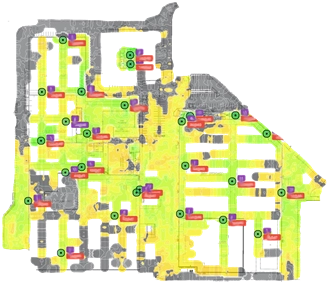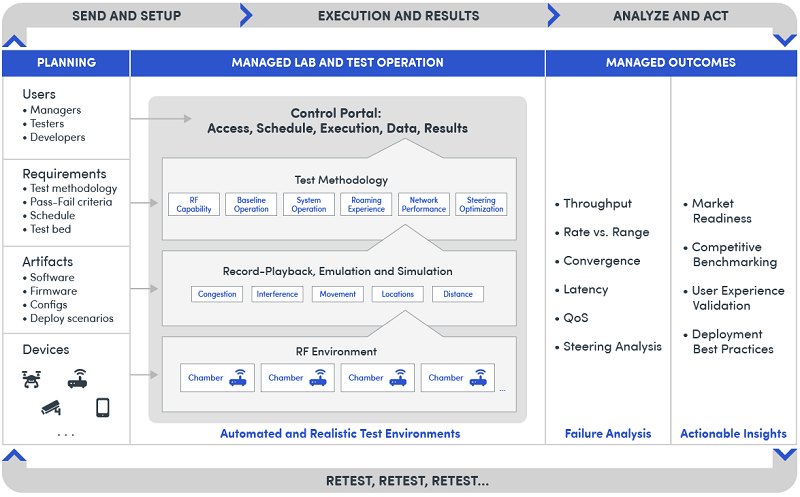Knowing that a certified device will interoperate in multi-vendor environments is important. But for service providers planning large-scale residential Wi-Fi deployments, validating conformance and interoperability is just the start.
When service providers are selecting Wi-Fi equipment for residential broadband deployments, you might think that evaluating device performance would be an obvious first step. It sounds straightforward enough: apply an objective, vendor-agnostic testing plan and make apples-to-apples comparisons. But this is one of those technology areas that sounds simple in theory but is actually quite complex. In fact, it’s challenged the industry for years.
There are, of course, tools that vendors and customers use to measure aspects of wireless performance. But for most of the history of Wi-Fi, standardized performance testing largely didn’t exist. Standards organizations offered highly effective testing frameworks to validate conformance with wireless standards and regulatory requirements governing RF airspace. Indeed, the massive success of Wi-Fi stems in no small part from testing regimes like the Wi-Fi Alliance, which gives customers confidence that any Wi-Fi-certified device will interoperate with any other in multi-vendor environments. When it comes to evaluating device performance, however, standards bodies have remained largely silent.
Now, that’s beginning to change. We recently published a white paper, The Importance of Performance Testing for Residential Wi-Fi Deployment detailing these efforts. The paper describes the challenges that have impeded standardized Wi-Fi performance testing and the evolving industry efforts to overcome them. The good news: while new technical hurdles continue to emerge, we finally have a solid foundation for standardized performance testing for diverse Wi-Fi use cases.
The Wi-Fi Performance Testing Challenge
Knowing that a certified device will interoperate in multi-vendor environments is obviously important. But for service providers planning large-scale residential Wi-Fi deployments, validating conformance and interoperability is just the start. They need to understand how different devices actually perform in subscriber households. After all, for the vast majority of residential customers (92% in the U.S. alone), Wi-Fi is a primary means of consuming broadband. The quality of experience that subscribers attribute to their provider increasingly depends on the performance of their Wi-Fi router or gateway—performance that service providers must be able to measure and understand.
Unfortunately, evaluating the performance of Wi-Fi equipment has historically been a difficult, expensive task, for multiple reasons:

Illustrative data taken during a walk test in a real building
Inside Wi-Fi Performance Testing
Given the many variables involved in gauging performance, vendors have been reluctant to adopt any framework that might give the impression that one product is objectively “better” than another. Instead, they’ve advocated a “fit-for-purpose” approach that would allow customers to compare different devices’ suitability to specific environments and applications. The growing acceptance of this approach, along with ongoing advances in testing technologies, has laid the groundwork for the standardized Wi-Fi performance testing that service providers have been clamoring for.
Today, multiple industry groups have issued standardized Wi-Fi performance testing plans, each geared towards different purposes. These include:
Together, the new testing standards give service providers powerful new tools to plan and support residential Wi-Fi deployments. For the first time, they can evaluate Wi-Fi performance for specific use cases in meaningful ways, using consistent, in-depth testing plans from industry groups they trust.
Of course, this doesn’t mean that the performance testing challenge is “solved.” Wi-Fi is a constantly evolving technology, and new features are developed all the time. For example, performance testing specifications don’t yet address new Wi-Fi 6 and 7 features such as advanced power-saving mechanisms, multi-link operation, and others that add even more complexity. Just as important, Wi-Fi performance is becoming mission-critical for more and more applications. For augmented reality, smart home connectivity, and many others, the ability to maintain consistent latency, throughput, coverage, and other performance metrics will be essential.
Learn More
Want to know more about how the Wi-Fi testing landscape is changing, and how industry leaders are attacking the performance testing challenges of the future? Download the white paper.
OCTOBOX testbed enables developers to ensure exacting high-performance requirements of the next generation of wireless devices
OCTOBOX is the only platform that can comprehensively test stringent Wi-Fi 7 standards by characterizing the unique capabilities of Wi-Fi 7 now and in the future as the requirements and related test cases evolve. With a modular design for easy upgrades, OCTOBOX provides a controlled environment to emulate real-world conditions in a repeatable manner, combining high performance instrumentation and analysis capabilities with the most sophisticated automation software. OCTOBOX simplifies Wi-Fi 7 test set-up, reduces testing duration, and enhances repeatability, resulting in actionable business outcomes.
“Spirent OCTOBOX is ready to test the rigorous requirements of Wi-Fi 7 with a robust, fully automated market-leading test platform. Our solution provides realistic deployment of varied environments, traffic, and interferer conditions to test real-world conditions in the lab, mimicking conditions found in a home, office, or stadium,” says Kimery. “As Wi-Fi 7 momentum builds, OCTOBOX is tailored to these new enhancements with detailed analysis, easy-to-understand results, and rich troubleshooting to help ensure that routers and devices are ready for deployment.”
Latest capabilities include:
OCTOBOX with Wi-Fi 7 will be shown for the first time at SCTE Cable-Tec Expo 2023 in Colorado (October 16 – 19), booth #842, or for more information visit https://www.spirent.com/wifi.
Enterprises and consumers alike have come to rely heavily on Wi-Fi. It’s a familiar cycle: users push Wi-fi to its breaking point and new iterations are ushered in to address the next wave of demand.
Most recently, Wi-Fi 6 and now Wi-Fi 6E have introduced advanced technologies to support the latest needs. These advancements are getting the job done but have introduced a range of complexities to accomplish increasingly impressive connectivity feats.
For instance, Wi-Fi 6 completely changed the radio interface. Instead of simply managing radio interface resources with one access point, Wi-Fi 6 now looks a lot more like cellular, with mesh networks comprising multiple access points and extenders to achieve fuller coverage.
In some ways, the new Wi-Fi generation is a bigger quantum shift in technology than what cellular has gone through as it migrates from 4G to 5G.
But what are the implications on testing?
For decades, Wi-Fi device simplicity limited the need for testing standards.
This is changing.
The latest iterations demand standards implementations to ensure interoperability and quality of service.
The Broadband Forum provides specifications for single access points or routers. The Wi-Fi Alliance is attacking performance testing standards and European groups are working on mesh test performance standards. Any gaps in standards are filled by test vendors like Spirent that create proprietary test scripts.
At the same time, the number of Wi-Fi 6/6E devices are growing. These newer devices provide more robust functionality and support increasingly stringent applications. They often reside in mesh networks.
Wi-Fi device testing needs to account for the variable conditions in which these emergent devices are expected to thrive. To accomplish this, the latest testing practices see devices isolated from outside interference in anechoic chambers that require specialized technical expertise. Testbeds are expected to create realistic conditions and enable test repeatability through programmable testing environments. These protocols must evolve as new standards are introduced.
The costs and complexities of establishing, managing, and configuring a comprehensive future-ready Wi-Fi testing lab can be daunting and expensive.
For Wi-Fi to remain relatively low-cost, seamless, and ubiquitous, the industry needs an easy and economical way to test all the new Wi-Fi devices coming to market.
Manufacturers want to ensure devices meet standards. Sales and marketing groups are looking for competitive benchmarking data. Service providers want to validate device updates and enterprises want to compare options.
Building and managing a Wi-Fi test lab might not be economical nor timely for those who are not prepared or don’t have access to the appropriate resources and staffing. This is especially true as the goalposts continue to move in a Wi-Fi 6/6E world. This is giving rise to managed services that alleviate much of the cost, expertise, and infrastructure burdens associated with the latest testing demands.
With Test as a Service, devices are sent to the Wi-Fi lab, standard or customized realistic tests are selected, and the tests are run. Detailed analysis of the device’s performance and any issues found are documented with comprehensive empirical data. Automated test scripts are essential for reducing costs and enabling scalability and test reproducibility.

TaaS for Wi-Fi Devices manages every aspect of device performance testing
The entire process is managed by the Test as a Service provider, which operates a comprehensive lab testbed, testing chambers, and automated test cases. They hire and train the experts and stay up to date on standards.
Test as a Service delivers myriad benefits, including:
If device testing is not your core competency or if you need added support, Wi-Fi Test as a Service is a faster, less expensive approach. Learn about Spirent’s Test as a Service for Wi-Fi devices.